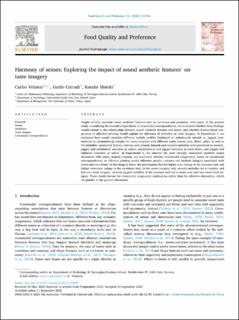Harmony of senses: Exploring the impact of sound aesthetic features' on taste imagery
Journal article, Peer reviewed
Published version

Permanent lenke
https://hdl.handle.net/11250/3092114Utgivelsesdato
2023Metadata
Vis full innførselSamlinger
Originalversjon
10.1016/j.foodqual.2023.104992Sammendrag
People reliably associate visual aesthetic features such as curvature and symmetry with tastes. In the present study, considering the transitive hypothesis of crossmodal correspondences, we evaluated whether these findings would extend to the relationship between sound aesthetic features and tastes, and whether feature-based congruency or affective priming would explain the influence of melodies on taste imagery. In Experiment 1, we evaluated how people associate different melody profiles (balanced vs. unbalanced, smooth vs. jagged, symmetrical vs. asymmetrical, simpler vs. more complex) with different tastes (sweet, sour, bitter, salty), as well as the melodies' associated fluency, valence, and arousal. Smooth and complex melodies were perceived as sweeter, jagged and unbalanced melodies as sourer, asymmetrical and jagged melodies as more bitter, and jagged and balanced melodies as saltier. In Experiment 2, we selected the most strongly associated aesthetic sound dimension with tastes, namely contour, and evaluated whether crossmodal congruency, based on crossmodal correspondences, or affective priming would influence people’s sensory and hedonic imagery associated with sweet and sour foods. In the imagery tasks, the participants showed higher sour ratings in the sourness task and higher sweetness ratings in the sweetness task. In the sweet imagery task, smooth melodies led to sweeter and less sour food imagery, whereas jagged melodies in the sourness task led to more sour and less sweet food imagery. These results favour the crossmodal congruency explanation rather than the affective alternative, which we ponder in the general discussion.
